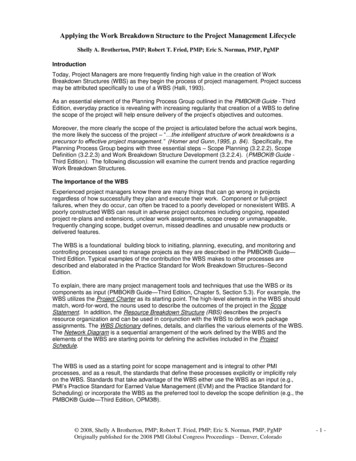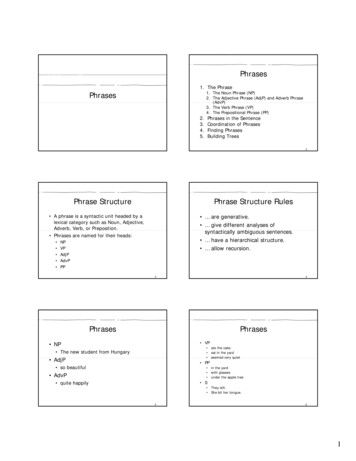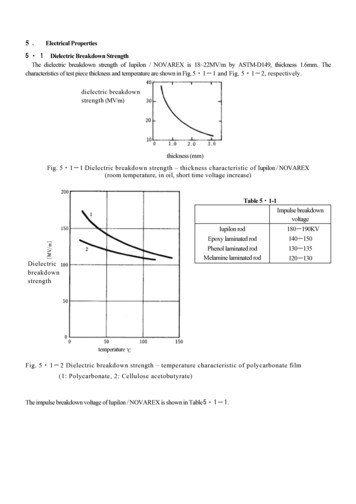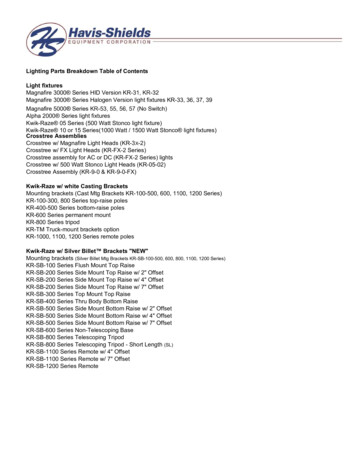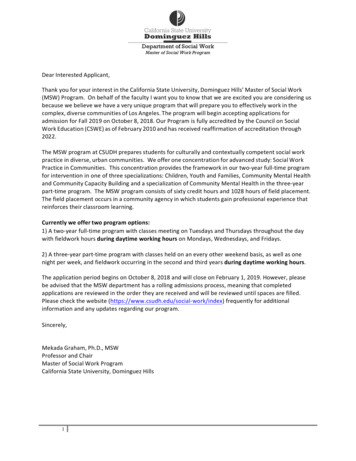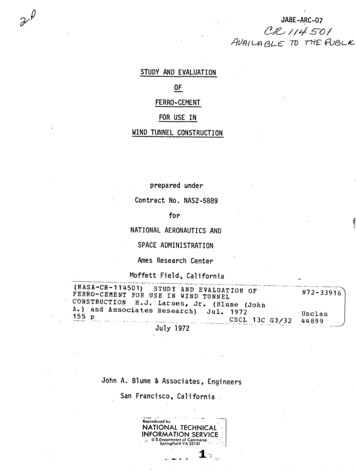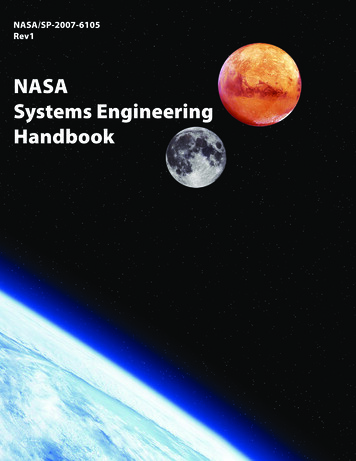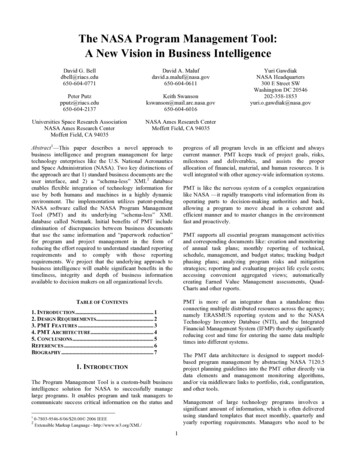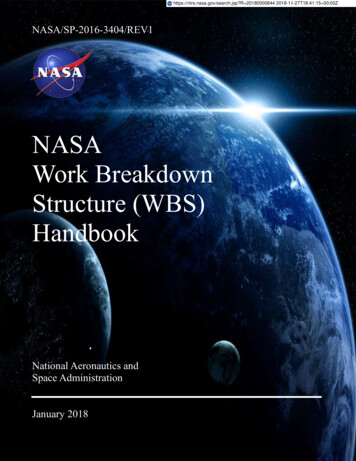
Transcription
https://ntrs.nasa.gov/search.jsp?R 20180000844 2018-11-27T18:41:15 00:00ZNASA/SP-2016-3404/REV1NASAWork BreakdownStructure (WBS)HandbookNational Aeronautics andSpace AdministrationJanuary 2018Page
NASA STI Program in ProfileSince its founding, NASA has been dedicated tothe advancement of aeronautics and spacescience. The NASA scientific and technicalinformation (STI) program plays a key part inhelping NASA maintain this important role. CONFERENCE PUBLICATION.Collected papers from scientific andtechnical conferences, symposia, seminars,or other meetings sponsored orco-sponsored by NASA.The NASA STI program operates under theauspices of the Agency Chief InformationOfficer. It collects, organizes, provides forarchiving, and disseminates NASA’s STI. TheNASA STI program provides access to the NTRSRegistered and its public interface, the NASATechnical Reports Server, thus providing one ofthe largest collections of aeronautical and spacescience STI in the world. Results are published inboth non-NASA channels and by NASA in theNASA STI Report Series, which includes thefollowing report types: SPECIAL PUBLICATION. Scientific,technical, or historical information fromNASA programs, projects, and missions,often concerned with subjects havingsubstantial public interest. TECHNICAL TRANSLATION.English-language translations of foreignscientific and technical material pertinent toNASA’s mission. TECHNICAL PUBLICATION. Reports ofcompleted research or a major significantphase of research that present the results ofNASA Programs and include extensive dataor theoretical analysis. Includes compilationsof significant scientific and technical data andinformation deemed to be of continuingreference value. NASA counter-part of peerreviewed formal professional papers but hasless stringent limitations on manuscript lengthand extent of graphic presentations.TECHNICAL MEMORANDUM.Scientific and technical findings that arepreliminary or of specialized interest,e.g., quick release reports, workingpapers, and bibliographies that containminimal annotation. Does not containextensive analysis.Specialized services also include organizingand publishing research results, distributingspecialized research announcements and feeds,providing information desk and personal searchsupport, and enabling data exchange services.For more information about the NASA STIprogram, see the following: Access the NASA STI program home pageat https://www.sti.nasa.gov E-mail your question to help@sti.nasa.gov Phone the NASA STI Information Desk at757-864-9658 Write to:NASA STI Information DeskMail Stop 148NASA Langley Research CenterHampton, VA 23681-2199CONTRACTOR REPORT. Scientific andtechnical findings by NASA-sponsoredcontractors and grantees.Page ii
NASA/SP-2016-3404NASAWork BreakdownStructure (WBS)HandbookNational Aeronautics andSpace AdministrationJanuary 2018NASA Work Breakdown Structure (WBS) HandbookPage iii
This handbook is available in electronic form athttps://ntrs.nasa.govNASA Work Breakdown Structure (WBS) HandbookPage iv
TABLE OF CONTENTSTable of ContentsList of Figures and IllustrationsRecord of RevisionsvviiviiiPrefaceP.1 PurposeP.2 ApplicabilityP.3 ReferencesixixixixChapter 1: Introduction1.1 Background Information1.2 Policy111Chapter 2: WBS Overview2.1 Definition2.2 WBS Hierarchy2.2.1 Establishing and Maintaining WBS Codes in NASA’s Management Systems2.2.2 Contract Work Breakdown Structure (CWBS) and CWBS Dictionary2.2.3 Work Breakdown Structure Elements by Other Performing Entities2.3 Development Guidelines2.4 Summary223579910Chapter 3: WBS Development and Control3.1 WBS and the Project Life Cycle3.2 WBS Activities and Responsibilities3.3 Development Considerations3.3.1 Compatibility between WBS and CWBS3.3.2 Compatibility with Internal Management Systems3.3.3 Correlation with Other Requirements3.3.4 Number of Levels3.3.5 All Inclusiveness3.3.6 Change Control3.4 WBS Development Techniques3.4.1 Preparing Functional Requirement Block Diagrams3.4.2 Coding WBS Elements in a Consistent Manner3.4.3 Preparing Element Tree Diagrams3.4.4 Preparing a WBS Dictionary3.4.5 Using Development Checklists3.4.6 Using WBS Templates3.5 Common Development Errors3.5.1 Using Unsuitable Former WBS3.5.2 Non-Product Elements3.5.3 Center Breakouts at Inappropriate Levels3.5.4 Incorrect Element 133NASA Work Breakdown Structure (WBS) HandbookPage v
Chapter 4: WBS Uses4.1 Technical Management4.1.1 Specification Tree4.1.2 Configuration Management4.1.3 Integrated Logistics Support4.1.4 Test and Evaluation4.2 Work Identification and Assignment4.3 Schedule Management4.4 Cost Management4.5 Performance Management4.6 Risk ManagementAPPENDIX A:APPENDIX B:APPENDIX C:DescriptionsAPPENDIX D:APPENDIX E:3536363636373738394041Acronym Listing43Glossary of Terms45Standard Project WBS Level 2 Templates and WBS Dictionary Content47Standard Data Requirements Document (DRD)55Contractor CWBS Example57NASA Work Breakdown Structure (WBS) HandbookPage vi
List of Figures and -4Project Development Cycles and Activities 2WBS Levels Illustration . .4Partial WBS with Numbering System. . 5Illustration – WBS Code Request Template for Programs/Projects . . 7Illustration – MdM Code Import Template . 7WBS/CWBS Relationship . 8WBS and the Project Life Cycle. . 11WBS Product and Enabling Support Content . . . 12WBS Development Activities & Responsibilities. . . 14WBS Relational Interfaces to NASA Business/Management Systems . 16WBS Cross-Reference Matrix . . 17WBS Hierarchy Illustration . . 18Relationships between WBS, OBS, CA, WP, and PP . . 20Agency WBS Numbering System. . 22Partial WBS Tree Diagram Illustrating Recommended Practices . . 24Sample Software WBS Illustration . . 25Example – WBS Index Excerpt . 26WBS Dictionary Example .28WBS Checklist Example 29Unsuitable Non-Product, Phase-Oriented WBS 31Unsuitable Functional/Organizational Oriented WBS. . .31Center Breakout Guidance for a WBS . 33Illustration of Incorrect Element Hierarchy . 34The WBS as a Project Management Tool for Integration . .35Responsibility Assignment Matrix (RAM) 38WBS and the Development of the Performance Measurement Baseline . 41WBS Serves as a Common Reference Point in Risk Management . . 42NASA Work Breakdown Structure (WBS) HandbookPage vii
Record of RevisionsREVDESCRIPTIONLTRDATEBasic IssueJanuary 2010AMiscellaneous Minor RevisionsOctober 2016BMiscellaneous Minor RevisionsJanuary 2018NASA Work Breakdown Structure (WBS) HandbookPage viii
PrefaceP.1PurposeThe purpose of this document is to provide program/project teams necessary instruction andguidance in the best practices for Work Breakdown Structure (WBS) and WBS dictionarydevelopment and use for project implementation and management control. This handbook can beused for all types of NASA projects and work activities including research, development,construction, test and evaluation, and operations. The products of these work efforts may behardware, software, data, or service elements (alone or in combination). The aim of this documentis to assist project teams in the development of effective work breakdown structures that providea framework of common reference for all project elements.The WBS and WBS dictionary are effective management processes for planning, organizing, andadministering NASA programs and projects. The guidance contained in this document isapplicable to both in-house, NASA-led effort and contracted effort. It assists management teamsfrom both entities in fulfilling necessary responsibilities for successful accomplishment of projectcost, schedule, and technical goals.Benefits resulting from the use of an effective WBS include, but are not limited to: providing abasis for assigned project responsibilities, providing a basis for project schedule and budgetdevelopment, simplifying a project by dividing the total work scope into manageable units, andproviding a common reference for all project communication.P.2ApplicabilityThis handbook provides WBS and WBS dictionary development guidance for NASAHeadquarters, NASA Centers, the Jet Propulsion Laboratory, inter-government partners, academicinstitutions, international partners, and contractors to the extent specified in the contract oragreement.P.3ReferencesNPD 7120.4, NASA Engineering and Program/Project Management PolicyNFS Part 1834, Major Systems AcquisitionElectronic Industries Alliance (EIA)-748, Earned Value Management Systems StandardNPR 7120.5, NASA Space Flight Program and Project Management RequirementsNPR 7120.7, NASA Information Technology and Institutional Infrastructure Program and ProjectRequirementsNPR 7120.8, NASA Research and Technology Program and Project Management RequirementsMIL-STD-881, Department of Defense Standard Practice, Work Breakdown Structures forDefense Materiel ItemsPMI 978-1-933890-13-5, Practice Standard for Work Breakdown StructuresNASA/SP-3705, NASA Space Flight Program and Project Management HandbookNASA/SP-6105, NASA Systems Engineering HandbookNASA Work Breakdown Structure (WBS) HandbookPage ix
Chapter 1: Introduction1.1Background InformationIn accordance with NFS Part 1834, Major Systems Acquisition, NASA policy NPD 7120.4, NASAEngineering and Program/Project Management Policy, and directives NPR 7120.5, NASA Space FlightProgram and Project Management Requirements, NPR 7120.7, NASA Information Technology andInstitutional Infrastructure Program and Project Requirements (NID 7120.99 Interim Directive), NPR7120.8, NASA Research and Technology Program and Project Management Requirements, the WBS andWBS Dictionary are mandatory elements of a project’s management baseline. This section providesgeneral WBS information including policy, definition, guidelines, and development process.1.2PolicyPer NPR 7120.5, NPR 7120.7/NID 7120.99 Interim Directive, NPR 7120.8, and NFS Part 1834 a projectWBS is a key element of NASA project management processes. The WBS and WBS Dictionaryrequirements contained in these three documents apply to all types of NASA programs and projectsdepending on the product line involved. The WBS is a core element of a project’s baseline throughoutall life cycle phases. It is the responsibility of each project manager and their project team to ensure thatthe WBS requirements are adhered to, not only during initial WBS development, but also in its on-goingmaintenance and control. The standard project WBS structures and templates identified in the aboveNPRs were intended to apply only to new projects established on or after June 1, 2005.NASA Work Breakdown Structure (WBS) HandbookPage 1
Chapter 2: WBS Overview2.1DefinitionEach NASA program has a set of goals which are developed from NASA mission needs. These programgoals are expanded into specific project objectives. The function of management is to plan and directproject activities to achieve the program goals. The WBS is to be generated and utilized as a key tool bymanagement in order to execute the project/program.A WBS is a product-oriented family tree that identifies the hardware, software, services, and all otherdeliverables required to achieve an end project objective. The purpose of a WBS is to subdivide theproject’s work content into manageable segments to facilitate planning and control of cost, schedule, andtechnical content. A WBS is developed early in the project development cycle as reflected below withinFigure 2-1. It identifies the total project work to be performed, which includes not only all NASA inhouse work content, but also all work content to be performed by contractors, international partners,universities, or any other performing entities. Work scope not contained in the project WBS should notbe considered part of the project. The WBS divides the work content into manageable elements, withincreasing levels of detail.Figure 2-1: Project Development Cycles and ActivitiesA WBS is developed by first identifying the system or project end item to be structured, and thensuccessively subdividing it into increasingly detailed and manageable subsidiary work products orelements. Most of these elements are the direct result of work (e.g., assemblies, subassemblies, andcomponents), while others are simply the aggregation of selected products into logical sets (e.g., buildingsand utilities) for management control purposes. In either case, the subsidiary work product has its ownNASA Work Breakdown Structure (WBS) HandbookPage 2
set of goals and objectives which must be met in order for the project objectives to be met. Detailed taskswhich must be performed to satisfy the subsidiary work product goals and objectives are then identifiedand defined for each work product or element on which work will be performed.Completion of an element is both measurable and verifiable based upon specific completion criteriaestablished during upfront project planning by the project team. Because WBS element/productcompletion can be verified, a WBS provides a solid basis for technical, schedule, and cost plans andstatus. No other structure (e.g., code of account, functional organization, budget and reporting, costelement) satisfactorily provides an equally solid basis for incremental project performance assessment.2.2WBS HierarchyThe project WBS structure should encompass the entire project’s approved scope of work. It usuallyconsists of multiple levels of products along with associated work content definitions that are containedin a companion document called the WBS Dictionary. All NASA projects have the capability ofsubdividing the work content down to any level necessary for management and insight. However, theAgency’s Core Financial System currently limits the ability to capture costs to a maximum of sevenlevels. These seven levels of the WBS are defined below. Level 1 is the entire project. Level 2 elements are the major operational product elements along with key common, enablingproducts (as defined in NPR 7120.5, NPR 7120.7 (NID 7120.99 Interim Directive), and NPR7120.8 standard WBS templates). Level 3-7 contains further definable subdivisions of the products contained in the level 2 elements(e.g., subsystems, components, documents, functionality).There are numerous terms used to define level three and succeeding levels of the WBS below the systemlevel. Some typical examples used for hardware and software product elements are subsystem,subassembly, component, module, functionality, equipment, and part. Project management and otherenabling organizational support products should use the subdivisions and terms that most effectively andaccurately depict the hierarchical breakdown of project work into meaningful products.A properly structured WBS will readily allow complete aggregation of cost, schedule, and performancedata from lower elements up to the project or program level without allocation of a single element ofwork scope to two or more WBS elements. WBS elements should be identified by a clear, descriptivetitle and by a numbering scheme as defined by the project that performs the following functions: Identifies the level of the WBS element. Identifies the higher-level element into which the element will be integrated.The following general illustration depicts how work scope can be arranged as hierarchical WBS levelsof work within a project. All project effort must be included, including all NASA in-house, contracted,international partner, university, and any other performing entity implementations. Enablingorganizational common products must also be reflected appropriately with a project WBS (e.g., ProjectManagement, Safety & Management Assurance (S&MA), Systems Engineering and Integration (SE&I)).NASA Work Breakdown Structure (WBS) HandbookPage 3
Figure 2-2: WBS Levels IllustrationThe following portion of a project WBS reflects an example of the NASA authorized WBS numberingsystem. This numbering scheme is called the NASA Structure Management (NSM) system. For eachAgency project, the WBS established by the project team must use the NSM numbering scheme and alsomust correlate exactly through level seven to the corresponding financial accounting structure utilizedfor each project within the NASA Core Financial System. This requirement helps to ensure that projectcosts are applied to the correct work scope being implemented by the project. This process is necessaryfor carrying out successful Earned Value Management (EVM) processes.NASA Work Breakdown Structure (WBS) HandbookPage 4
Figure 2-3: Partial WBS with Numbering SystemThe top two levels of a project WBS are dictated and controlled by the Agency through standard, leveltwo WBS templates. These templates, along with their associated narrative content descriptions, arecontained in the NASA Space Flight Program and Project Management Handbook (NASA/SP-3705),NPR 7120.7 (NID 7120.99 Interim Directive Appendix H for Information Technology projects), andNPR 7120.8 (Appendix K for Technology Development projects). WBS levels 3 and lower are developedand should be controlled by project management and, as-required, prime contractors that are involved inproject implementation. In cases where prime contractors are involved, lower-level element coding mustbe traceable to the appropriate upper-level elements that are controlled by the NASA Project Manager.While not being a requirement, it is recommended that the prime contractor lower-level WBS numberingscheme be consistent with the overall project WBS numbering format. This will allow easier total projectintegration of cost and EVM data for project reporting.NASA standard level-two WBS templates and narrative descriptions can be found in Appendix C.2.2.1Establishing and Maintaining WBS Codes in NASA’s Management SystemsAll Programmatic and Institutional WBS element codes are not recognized as official NASA structuresuntil first being approved and established in the Agency’s Metadata Management (MdM) system. TheNASA Work Breakdown Structure (WBS) HandbookPage 5
MdM system is a web-based enterprise application that contains the Agency’s official NSM data elementsand associated attributes. MdM is the only Agency application used for identifying, creating, tracking,organizing and archiving of Appropriation, Mission, Theme, Program, Project, and Work BreakdownStructure (WBS) 2 through 7 NSM structural elements. As the Agency’s enterprise repository for NSMdata, MdM supplies WBS codes to the Agency’s Core Financial System and the Budget FormulationSystem as they require programmatic and hierarchical coding of data content. The WBS approval processinvolves designated MdM code requesters/approvers that have been established across the Agency toreview new WBS elements requested by programmatic and institutional organizations. It should be notedthat project managers are not currently included as MdM code approvers. Because of this, all projectmanagers should continually monitor new WBS elements that are added to their projects for validity andcorrectness.Process instructions for entering new or modifying existing, WBS elements within the MdM system maybe obtained from the designated MdM code requester point of contact at each NASA Center. Additionalinformation regarding the MdM system may also be obtained by contacting the MdM Help Desk(mdmhelpdesk@hq.nasa.gov). All modifications made to existing WBS element codes contained inAgency management systems li
Jun 01, 2005 · management in order to execute the project/program. A WBS is a product-oriented family tree that identifies the hardware, software, services, and all other deliverables required to achieve an end project objective.
